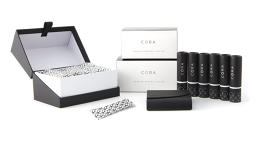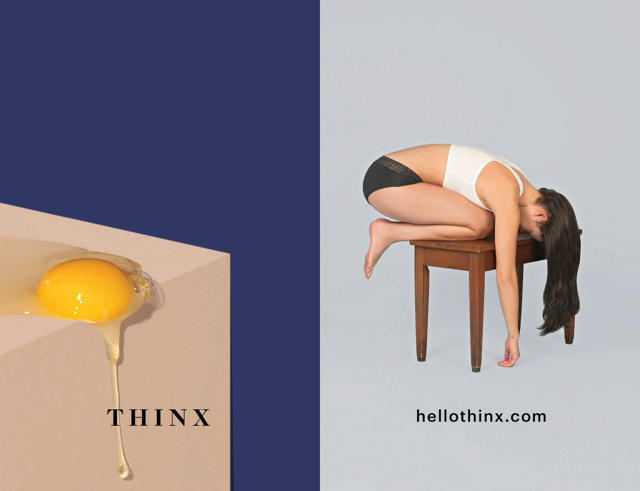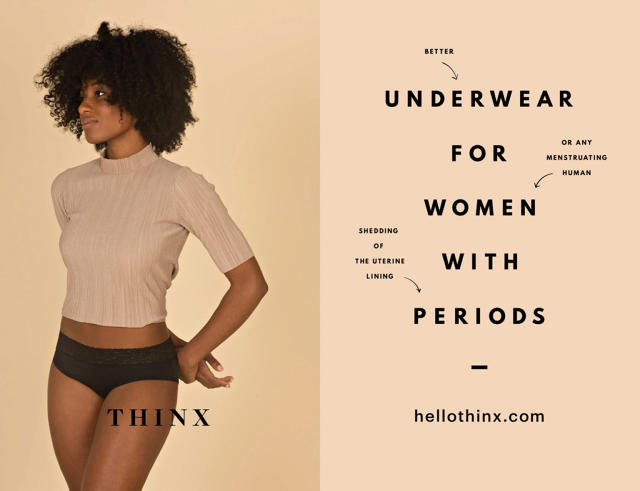Bleeding On The Job: A Menstruation Investigation
Nancy Kramer, founder and CEO of the 330-person marketing agency Resource, was sitting in a swanky conference room in Silicon Valley with a potential client. She steeled herself in the moments before her presentation, ready to clinch a multi-million dollar deal. As negotiations heated up, she suddenly felt a trickle between her legs. She performed some mental calculations and realized that her period had arrived early. Unprepared, she excused herself to go to the bathroom only to find that there was not a tampon or pad dispenser in sight. She returned to her seat at the table, trying desperately not to get sidetracked by fear that she might leave the meeting with an unsightly stain at the back of her dress or worse, on the chair.
Kramer landed the contract, but a decade later, she still describes the day as an “emotional ordeal.” And her experience is far from exceptional. In fact, a recent study found that 86% of American women have started their period unexpectedly in public without the supplies they needed. They report feeling panicked, embarrassed, and stressed. “There’s not a woman that I’ve met that doesn’t have a story,” Kramer says.
I interviewed three dozen women for this article, all from a variety of backgrounds and professions—from tech executives and flight attendants to chefs and cashiers—and I asked each of them how their periods affect their work. One thing was clear across the spectrum: Menstruating at work is still a messy, unpleasant experience. And it’s hard to talk about because it’s shrouded in shame and anxiety. Case in point: Most of the women I spoke with asked not to be identified by name.
But a cultural shift seems to be underway. Over the last year, there’s been a spike in menstrual activism. A runner making a statement by bleeding openly in a marathon. An artist posting pictures on Instagram with blood spots on her clothing. A CEO crusading for tampons to be available in schools and offices. Last month, the state of New York made history by passing a law that ensures that girls and women in public schools, shelters, and correctional facilities have access to menstrual products. Meanwhile, 15 of the 40 states that still have a “tampon tax” have moved to do away with it.
And it’s not just individuals who are moving the needle. Startups are also playing an activist role, helping break taboos. There are companies offering female consumers high-tech underwear that prevents staining and sleek, inconspicuous tampon carrying cases. And there’s at least one brand that upholds the proudly feminist message that periods are not embarrassing, dirty, or a sign of weakness.

Part One: Bleeding On The Job
Getting your period at the office is a disruptive affair that adversely affects productivity. Kramer has studied this phenomenon extensively for 30 years.
It all began in 1981, when she happened to visit Apple’s headquarters in Cupertino, California, and came across something she had never seen before: All the women’s bathrooms were stocked with baskets of tampons and pads. It was a revelatory moment. She began to wonder why menstrual products weren’t treated like toilet paper, freely available in all public restrooms. It was such a simple gesture that could dramatically improve an employee’s ability to do her job. “I was convinced that if men got periods, this wasn’t even a subject we’d be discussing,” she says.
Related: Could Menstrual Leave Be The Next Work-Life Benefit?
Since then, Kramer has been lobbying for offices to make menstrual supplies available to women for free. She’s calculated that it only costs $4.67 per woman, per year for a company to offer female employees these essential items. Three years ago, she took her efforts a step further by launching an organization called Free the Tampons and commissioned research by Harris Interactive, surveying 1,072 U.S. women age 18 and over, to better understand the impact of periods in the workplace.
The study brought to light hundreds of anecdotes from women who have suffered through humiliating menstruation moments at work. A 58-year-old described how her period once came early, causing blood to soak through her underwear onto her office chair; ever since, she’s left an extra pair of trousers at the office. A 39-year-old explained that one of the most stressful parts about getting her period at work is trying to hide it from the men surrounding her. “You have to make it past all your noisy male coworkers who are watching you go back and forth to the restroom,” she told the Harris researchers. She’s not the only one who feels this way: Five percent of women don’t carry their purse to the restroom for fear that others will guess that it’s their time of the month.
During my own interviews for this article, I heard the same story again and again: Being unprepared to get your period at the office is common and extremely stressful. While the majority of women might keep their purses and desks stocked with menstrual supplies, it only takes one instance of unplanned bleeding for things to go horribly wrong.
My anecdotal findings were confirmed by the Harris study, which found that when women didn’t have tampons or pads on hand, 51% had forgotten to refill their emergency stash, 48% only carried them when they were expecting their period, and 24% didn’t have their purses handy when they needed them. One 44-year-old woman in the study explained her thought process during a period crisis. “My first response is usually, ‘Oh shit!’ out of irritation,” she says. “Then I panic because I know I don’t have any supplies. I get angry with myself for not being prepared. Then, I pray I have quarters for the tampon machine, and then, I pray there is a dispenser.”
For all of Kramer’s efforts, it is still relatively uncommon for public restrooms to be equipped with a tampon or pad dispenser and it is even rarer for those products to be available for free. When vending machines exist in office bathrooms, they require exact change in the form of a quarter (or in older machines, a dime). “The place I work does have a dispenser,” a 27-year-old Lowes employee says. “But it is never filled, so it’s pretty much a useless dispenser.”

When menstrual blood makes a surprise appearance at work, the employee must take time out of her schedule to come up with a solution: 62% of women go to a drugstore to buy supplies, 53% ask their coworkers if they have anything on hand, and 34% go home for what they need.
Of course, there are moments when none of these options are possible, as was the case for Kramer, who had to return to that conference room to close the deal. So she did what 79% of women have done at one point or another. “I had to roll up a wad of toilet paper between my legs to take the meeting,” she says. Almost every women I spoke to could relate to crudely “MacGyvering” panty protection and they all describe it as an uncomfortable experience that threw off their concentration for the day. Even with the right supplies, women with particularly heavy periods often bleed through them.
In developing countries, where women don’t have access to effective menstruation products, they miss what amounts to months of school or work every year. While that problem is nowhere near as bad in the United States, the fertility app Clue conducted a survey and found that 18% of American women have missed work out of fear that someone might discover they are menstruating. This doesn’t even account for the hours lost trying to finesse one’s way through an unexpected period.
Clue’s study found that 68% of women did not feel comfortable speaking to men at work about their period, which can have a negative impact on a woman’s workday. A journalist friend of mine described how she once leaked onto a white dress and desperately needed to go to the bathroom to wash it out, but she had a couple of meetings to attend and didn’t feel comfortable asking her male editor for half an hour to take care of the problem. “I just awkwardly tried to make sure nobody saw my back,” she recalls. “Of course, I couldn’t think of anything else the rest of the day.”
Part Two: Startups Busting the Period Taboo
Over the last few years, female entrepreneurs have noticed that the menstrual product industry is ripe for disruption.
As menstrual activism has heated up, these businesswomen have treated product innovation as a way to join the fight to de-stigmatize periods and improve women’s quality of life.
In 2014, Miki Agrawal co-founded the company Thinx, which makes blood-absorbing underwear. She describes herself as a “period taboo buster,” and earlier this year, she fought hard to place ads throughout the New York subway system, only to get stonewalled by the MTA because her signs contained the word “period.” “They thought the very idea of putting period ads on the subway was disgusting,” she says.
When word got out that the MTA had turned her down, it was met with outrage on social media and websites like Mic. Eventually, the MTA capitulated, and train cars were soon plastered with large, provocative images suggestive of the female reproductive system: grapefruit artfully made to look like a vagina and runny eggs that evoked menstrual blood. “We wanted it to feel more like an art gallery experience rather than an advertising experience,” Agrawal says.
The ad copy was much more direct. One poster read: “Why are there period ads everywhere? The better question is: Why shouldn’t there be? There’s a 1 in 12 chance that you are on your period right now, yet we rarely discuss menstruation outside of whispers woman to woman. Today, we can change this.”
From Agrawal’s perspective, eradicating the stigma around menstruation is not just a matter of talking openly about it. It is also a question of developing products that make periods less awkward. “The first question for me was why there was no innovation in this category,” she says. “Why are women still leaking and staining and having accidents?” She points out that there have only been a few updates to feminine hygiene products over the last century: Tampons were invented in 1931, adhesive strips were added to pads in 1969, and menstrual cups entered the marketplace in the 1980s.
She and her cofounders spent three and a half years working with textile manufacturers to develop performance underwear that wicks moisture, absorbs up to two tampons’ worth of blood, and contains antimicrobial properties. (The washable, reusable panties cost between $24 and $38, depending on the style.) “Most importantly, they are comfortable,” Agrawal says. “They look and feel like regular underwear. In fact, they’re designed to make you feel beautiful.” To test her philosophy, five Fast Company writers, including myself, tried Thinx for several months. Our consensus was that they eased our minds about possible leaks, and importantly, did not feel clinical or utilitarian, thanks to pretty lace trims and funky colors.
Agrawal is quick to acknowledge that Thinx isn’t the first company to develop period panties. Triumph International, for instance, created a much more rudimentary version with a plastic lining in the 1980s, and in the early 1990s, Lunapanties came up with a more comfortable, cotton-based underwear that absorbed leaks. Four years ago, as Thinx hit the market, companies like Dear Kates and Knix popped onto the scene with similar offerings that are both functional and elegant, but as companies, they haven’t managed to scale as quickly or as effectively as Thinx. Part of this has to do with that fact that Thinx is better capitalized than its competitors, closing a Series A round of fundraising worth several million dollars, which allowed Agrawal and her team to invest in aggressive marketing like the New York subway ads.
Agrawal believes that Thinx has taken off not just because she has created a functional product, but because she has marketed it in a way that makes women feel cared for and empowered as they menstruate. “Every touchpoint that the consumer has with the brand, from the product to the website to the ads, needs to make a woman feel good about having her period,” Agrawal says. “It has to hit the mark in terms of aesthetic design, product innovation and in accessible, relatable brand communication. I believe that these three prongs coming together can change culture.”
Even though a study revealed that U.S. women prefer pads, purchasing, on average, 111 pads to 66 tampons per capita every year, tampons have benefitted from the most noteworthy advancements in feminine hygiene products.

The organic tampon startup Cora, which launched earlier this year, has tried to ease the inconvenience of menstruating via creative design. When founder Molly Hayward was thinking about packaging, she wanted to make carrying tampons to the bathroom inconspicuous. “Most tampon wrappers on the market come in bright pink or green wrappers,” she says. “I guess they are designed to look feminine, but there’s nothing remotely subtle about them.”
Cora tampons, on the other hand, are sealed in simple white wrappers with a black lattice pattern and come in an understated black box that store a cycle’s worth of supplies. The company also makes cardboard capsules that resemble lipstick-holders and hold individual tampons so they don’t get crushed in your handbag (and so you can hand one to a friend in need in without announcing she has her period). Cora even sells an elegant black clutch that evokes a 1920s cigarette case and serves as a discreet holder for those trips to the office bathroom.
Another one of the company’s innovations is that the tampons can be ordered online as part of a subscription model. Customers are asked to select the exact number of tampons they use for each period, with the right combination of regular or super absorbencies. Every quarter, the tampons arrive by mail (with a few extras, to be safe), so women are less likely to find themselves in a jam.
While Cora is in the business of making menses unobtrusive, the newly launched Conscious Period has taken the opposite approach. It has created a line of organic tampons that come in brightly colored wrappers, carefully designed to draw attention to themselves. “We grew up as part of a generation of women who were taught that our periods should be hidden away,” says cofounder Annie Lascoe, pointing out that pad commercials typically represent menstrual blood as blue liquid. “These subliminal messages reinforce period stigmas and really contribute to a culture of period shaming.”

Lascoe believes that the way to tackle the taboo is for women to be bold and assertive about their monthly cycles. Rather than waiting for male colleagues to become comfortable with women’s bodies, Lascoe believes that women can accelerate the process by proudly toting colorful tampons to the restroom. “We want to see a culture where periods can be discussed more openly, and it’s important to us that our products’ fun, happy packaging reflect that value,” she says.
Where Cora and Conscious Period do converge is in the common goal of creating a safer tampon. They’re part of a wave of organic cotton tampon startups like Lola and Kali that have exploded in the past year. These brands are trying to take a bite out of the multi-billion dollar global tampon market that’s dominated by Tampax, Playtex, and U by Kotex, all of which sell non-organic models.
While the FDA considers feminine hygiene products a medical device (albeit one not eligible for flexible spending dollars), the government focuses primarily on their efficacy in absorbing blood and does not require companies to disclose the full list of ingredients. There have not been comprehensive, longitudinal studies about how pesticides, synthetic materials, and other toxic chemicals like dioxin found in mainstream tampons affect women’s bodies.
But the recent burst of activity in the organic tampon market is another sign that further change is coming. Women are demanding more thoughtful and innovative solutions; they’re looking for brands that reflect their own nuanced stance on menstrual activism.

Part Three: What Will It Take to Really Change Culture?
Last summer, Kiran Gandhi got her period during the London Marathon, which she’d spent several months training for.
She didn’t know what to do. A pad would chafe and a tampon might get dislodged. Then she decided that she shouldn’t feel compelled to use any protection at all, so she decided to let blood flow down her leg throughout the race. “At first I was horrified by the idea of other people seeing my blood, but then it occurred to me how oppressed I was by own thinking,” she says. “I had a job to do, which was to run 26 miles, and there was no fucking way I was going to be more concerned about what the people on the sidelines eating popcorn were thinking.” The media immediately picked up her defiant message, and she became known as the free-bleeding marathon runner, frequently mentioned alongside Rupi Kaur, the artist who chronicled her everyday experiences with period blood on Instagram.
Right before the race, Gandhi had graduated from Harvard Business School, ready to launch a career in the music industry. She’s thought a lot about the politics of menstruating at work. While she supports the brands and activists working to transform how women experience their cycles, she makes the case that women often don’t want to talk about their period because they’re afraid they will be considered less competent than their male colleagues. “To go to your male boss and say that you need an hour because you’re experiencing horrible menstrual cramps feels embarrassing, but worse, it makes you feel like a terrible employee,” she says. “Because men don’t experience periods, they might assume that whatever you’re facing is not that bad.”
For her, then, it’s a matter of fighting for a workplace that not only accommodates women’s biology, but also doesn’t treat it as a weakness or an annoyance. In her ideal world, offices would have charts with women’s biometrics that revealed their hormonal state. “There are optimal times for productivity and social engagement with a client, for example,” she says. “Today women are so afraid that this kind of information will be used against them to make them seem weak, but what if instead, it was used by someone who did not have a sexist agenda and choose to turn period cycles to all our advantage?”
It’s unlikely such an enlightened workplace will become a widespread reality any time soon. But we can see glimpses of it already at the Thinx offices, where employees use the very charts that Gandhi envisioned, with lines and graphs indicating where they are in their cycle. Coworkers are aware when a team member is experiencing premenstrual tension or is likely to have cramps. In an ideal situation, they can be more sympathetic to one another. They believe that this approach actually makes everyone more productive.
It’s the kind of workplace where the CEO, Miki Agrawal, marches through the door and loudly announces, “I just felt one of my eggs drop!”
A regular menstruation utopia.
Fast Company , Read Full Story
(44)


















